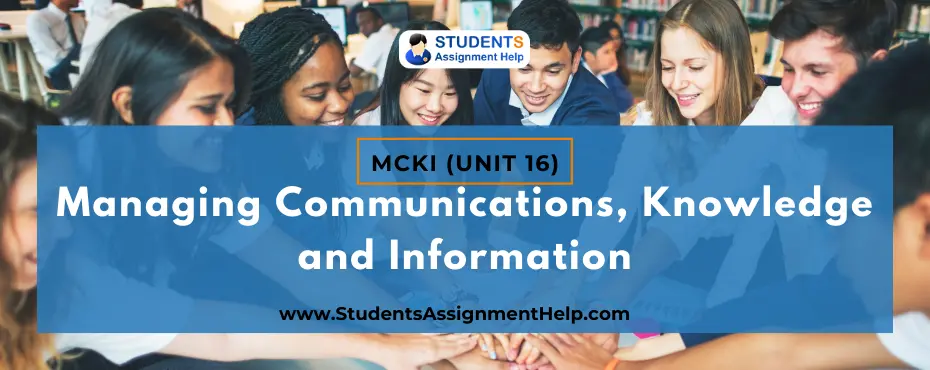MCKI (UNIT 16): Managing Communications, Knowledge and Information

In the fast moving business of automobiles, decisions need to be made equally fast and effective to survive in the market. From designs to accessories, from assembly line to the board rooms, the range of decision making in this industry is huge. But the hierarchy of this flow can be placed under the three main frameworks of decision making; Strategic, Tactical and Organizational. Whereas the strategic aspect decides the company’s approach towards the world market and demand along with new developments, innovation and selects a competitor, tactical aspect takes those decisions and puts them into action either on the workstation or through market research and analysis (Lamb and Lachow, 2006). The organizational aspect gathers all that there is to be gathered from the above two and puts them into motion in the assembly lines, showrooms, back office and customer support.
But to make a decision, the company and its staffs need to have the information about the market, the product, and everything that is related to it. It also needs to have clear and authentic information about its rivals or competitors in the market to decide on any matter from research and development to gimmicks and hoaxes (Andersson et al. 2002). Especially in the automobile industry, information related to foreign policy, the status of world peace, national affairs and other major political issues also play a vital role as these are the factors that determine the prices of fuel, raw materials and accessories. Along with that, environmental issues also need to be taken into account; the percentile of customers keen on bio-fuel or electric as alternative fuel source/ option. And there is also the responsibility towards habitat.
All this information can be gathered from many sources, at times, one does not even need to gather them; it finds its way in. But, to be able to make the right decision and that too fast, one must consider the authenticity of the same. This can be achieved by scrutinizing the source; internal and external. Internal sources include the market research team, the research and development team and the customer care or the client servicing team. The external source on the other hand includes the media, and the public relations team. In the automobile industry, these wings play a major role. For one, the internal sources help to determine the strengths and weaknesses of the company along with its ability to adapt to a change in any scenario. The resourcefulness of this sector, prepares the company in all aspects for better or for the worst. Secondly, the external sources helps the companies assess the market situation and predict and formulate a plan of action or the incorporation of new features or innovations in the product.
It is always recommended that the company upgrade these sources as the more authenticate the information, the better stand the company will have in the market (Gulati et al. 2000). A regular briefing and debriefing of the sources will on one hand smoothen the process streamlining it so that information is available at all times, and keep the company a step ahead in the market, on the other. As it is said, KNOWLEDGE IS POWER.

TASK 2
Given the complexity of the market now-a-days, to undergo a smooth decision making process, companies need to involve stakeholders in the process. A stakeholder can be anyone who is interested in the nature of business or is instrumental in the nature of business. In any given company, stakeholders are divided into two segments, internal, and external. Internal stakeholders are the employees and the employers, board of directors etc. External stakeholders are anyone with an interest in the business other than the above mentioned group. As far as the automobile industry is concerned, stake holders are varied, from the government itself, to the customers. The government becomes a stakeholder as its foreign and industrial policies influence a lot of decisions in this industry. Second important are the financiers, or shareholders, followed by the major oil producers. These stakeholders form the first tier as without their involvement, the industry would fall. Next in line are the customers and the environmentalists. The customers help decide what to produce, how much to produce, when to produce etc. whereas the environmentalists help decide how to produce at the given cost of production.
Thus keeping in touch with all the stakeholders at all times becomes a necessity for the company to survive. An effective customer care team and client servicing team is the start off point for this. Whereas the customer care team would regularly be in touch with the customers discussing their problems, and taking in their inputs, the client servicing team would help the company consider the interests of the financiers and the shareholders. Along with this, a projected transparency from the company also helps consolidate the interests of the stakeholders as well.
To involve these stakeholders in the decision making process, a company utilizes various resources. For one, the customers are regularly contacted or are in contact with the customer care that effectively gathers and disseminates information and their point of view from and for the company. Secondly, the public relations team might organize seminars and meets to discuss issues of interest for shareholders, financiers and the esteemed customers. These types of events help in streamlining the decision making process as this one to one interaction gives the company a chance to assess the views and ideas of all the stakeholders which is far more effective and efficient (Hansen, 2002).

To cultivate the most out of the situation, the company might involve its stakeholders in monthly debates and discussions on issues of interest such as usage of alternate fuel, or new designs for cars or new features to be added for the benefit of the customers (Quinn, 1992). These types of open houses involving the customers would give the company a chance to consider the demand and its type in the market in the most interactive way. And an open house with the shareholders and the financiers would shed light upon the resources. Thus, combining the two would give the company a chance to consider and compare the interests of all its stakeholders at the same time.
TASK 3
• A common aspect in all business organizations is the down line process of decision making i.e. communication.
• Generally, the established structure for it can be divided into three basic forms; Downward communication, Upward communication and Lateral communication.
• Upward communication happens when a junior report to his/ her senior for example, a sales representative reporting to his/ her sales manager or a customer care executive reporting to the team leader.
• Downward communication happens when a decision is passed on from the decision makers to the down liners for example, the board of directors to the managers.
• Lateral communication happens when information is passed on from one department to another, for example, the research and development team to the production team etc.
• In order to improve this type of communication, a company might adopt certain policies.
• Firstly, in case of upward communication, any information supported by data and facts and figures would ensure the attention of the up liners concerned.
• A clear and repetitive dissemination of information through the chain in the downward communication scenario would ensure effective implementation.
• In case of lateral communication, a detailed report along with reference would help the departments work smoothly and at the same time improvise as and when necessary.
• In any case or method of information flow, one thing that becomes important is follow up.
• A regular follow up keeps the progress in line and helps all the wings of the company work effectively.
• In the automobile industry, clear and effective transfer of information is mandatory thus implementation of strict procedures becomes a must. Simple add on like, data attachment, deadline declaration etc. have worked miracles in the past and are still doing so.
• A regular intra- staff and inter- staff meet is what would enhance the working further.
• A regular intra-staff meeting would process upward and downward communication regulating a transparency in the process.
• A regular inter-staff meeting would enhance the flow of lateral information transfer for the better working of the company.
• Regular post and reminders with an effective follow up would also ensure that all information is correctly and efficiently disseminated, and understood and absorbed by the respective heads.
• On a personal level, one should first understand the structure of the flow of information. Once that is understood well, one should create a flowchart and checklist for the process of dissemination.
• Other than that, indulging in inter-personal transfer of information also aids the clarification of issues and policies that at times grouped together becomes very complex and time consuming in the matter of transfer of information.
• Getting a clear concept is the key in such situation. Thus one needs to do everything with clear a concept so that the flow of information along with the overall working of the system gets an upper hand and is enhanced by the contribution made by one single person.

TASK 4
All the aspects discussed above are dependent upon the collection, storage, and dissemination of information and knowledge. Thus it becomes imperative for a company to have an effective body to do so. It is a practice in most of the organizations to collect information through channels like the market research teams, who venture into the market, researching and analysing the different aspects that concern the company, and customer care, who talk directly to the customers and take their feedback as to the products and services provided by the company (Lorenzoni and Lipparini, 1999). Some companies even have a separate after sales team to collect more information from the market. These segments or departments of a company, collects information and stores them in form of data that are disseminated in an upward communication and lateral communication process. The transferred information is then processed and a downward communication happens along with another lateral communication to help solving the issue. This is an established model that has come into being and is in process for many years.
The main problem in this system is that it is time consuming and often not efficiently done due to the loss of information in the process and interpretation. Thus to overcome this issue, organizations might opt for direct online help for the customers and stakeholders. In this process, a central database would be created where all information and decision would be stored for the stakeholders (Banbury and Mitchell, 1995). At the same time, all the employees of the company will be able to access it for necessary information and resolve issues at hand. As the stakeholders access the database to find solutions to their issues, they drop in their details which can be accessed by the concerned department, who then would be able to solve the issues faster and even disseminate the information faster as and when necessary. Thus, negating the chances of possible loss of information or wrong interpretation during the process of dissemination and improving the service of the company and the performance of the employees and the company in the market (Brown and Duguid, 1991).
These are really complex issues to deal out in one go for any company. But effective dissemination of information on both ends requires steady and methodical implementation (Lane and Lubatkin, 1998).

Firstly a central database with the existing details of the stakeholders needs to be created. Once accomplished, the board must provide the necessary information relevant to the issues that might concern the stakeholders through downward communication which would then be fed into the central database and compartmentalized according to the relevance with the stakeholders. Then access codes are to be generated for the employees so that they can access the information according to the issue at hand and disseminate information as and when required. Along with that, an option needs to be there so that new stakeholders can be incorporated and included into the database. If it so happens that an important decision is made and it needs to be disseminated, the database would automate a prompt for the employees to do so at the earliest. This way the accumulation and dissemination of information would take an effective and smoother form (Rulke et al. 2000).
SELF ASSESSMENT:
The assignment was an eye opener as in the process the main problem in any organization was addressed. Communication the method and a gap in it has a massive impact on the working of the organization. It is a chain that works and a glitch, however small, is enough to have a devastating effect. Thus it is mandatory for all organizations to have a clear cut and well defined hierarchy and an effective instrument for the dissemination of information. As based on this instrument only, escalations of problems and their solution happens.
This assignment enlightened me in the issue, giving me a chance to learn and assess myself and realize the importance of developing one’s communication skills.
The skills are not to be restricted to just inter-personal level but also should be adaptable and influential in all the forms of organizational communication processes. The importance of upward communication for shaping the status of an organization in the market was important. But now after the assignment is complete, it has become unavoidable. Similarly, the downward and lateral communication system projected its importance as the effective and smooth working of an organization not only means execution of orders; but it also means the execution of orders effectively and efficiently. As an organization may be considered as a machine, the interdependency amongst the departments becomes important as well. Thus a transparent flow of information within the departments ensures a smooth working of the organization.

The assignment also revealed the importance of stakeholders to any business as they, are the ones supporting the existence of the company in the market. A healthy relation with the stakeholders is important. The assignment proved that this can be achieved by a clear and transparent exchange of information with the stakeholders regarding issues concerning them along with the issues of or for the business in hand. The involvement of stakeholders in the process of decisions making also helps the business in the long run as they being the risk takers would always give suggestions that would help make more profit.
All these points once taken into consideration, helps understand the business in an angle that impacts the performance of an individual in the long run. As a businessman and leader, it is now easy for me to understand what policy to take, whom to consult, whom to approach for further business etc.
It has also shed light on the process of involving the financiers, how to grow their interest in the business and benefit from the benefit that they are receiving. Along with that, the assignment gave me an insight into the importance of inter-personal relation with the customers through after sales department and customer care as these are the departments that build up a goodwill for the company in the market.
Given the clarification that I achieved from the project, now it is easier for me to form effective strategies for the dissemination of information along with formulating a flowchart to address any issues at hand through the established modules of inter-organizational communication, to serve the clients and customers effectively.
Buy high-quality essays & assignment writing as per particular university, high school or college by UK, USA & Australian Writers
References:
Andersson U., Forsgren M. and Holm U. (2002) “The Strategic Impact of External Networks: Subsidiary Performance and Competence Development in the Multinational Corporation” Strategic Management Journal 23(11): 979–996
Banbury C. M. and Mitchell W. (1995) “The Effect of Introducing Important Incremental Innovations on Market Share and Business Survival” Strategic Management Journal 16:161–182
Brown J. S. and Duguid P. (1991) “Organizational Learning and Communities-of-Practice: Toward a Unified View of Working, Learning, and Innovation” Organization Science 2(1):40–57
Gulati R., Nohria N. and Zaheer A. (2000) “Strategic Networks” Strategic Management Journal 21(3): 203–216
Hansen M. T. (2002) “Knowledge Networks: Explaining Effective Knowledge Sharing in Multiunit Companies” Organization Science 13(3): 232–248
Lamb C. J., Lachow I. (2006). Reforming Pentagon StrategicDecision-making, Institute for National Strategic Studies.
Lane P. J. and Lubatkin M. (1998) “Relative Absorptive Capacity and Inter organizational Learning” Strategic Management Journal 19: 461–477
Lorenzoni G. and Lipparini A. (1999) “The Leveraging of Interfirm Relationships as a Distinctive Organizational Capability: A Longitudinal Study” Strategic Management Journal 20: 317–338
Quinn J.B. (1992) Intelligent Enterprise: A Knowledge and Service Based Paradigm for Industry, New York: Free Press
Rulke D. L., Zaheer S. and Anderson M. H. (2000) “Sources of Managers’ Knowledge of Organizational Capabilities” Organizational Behavior and Human Decision Processes 82(1): 134–149

